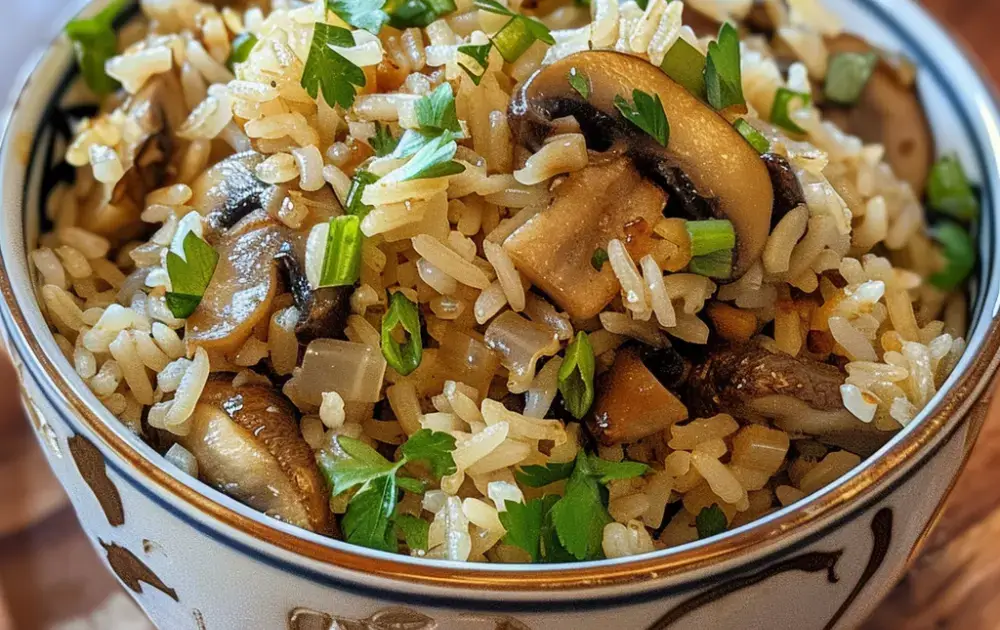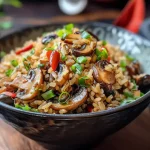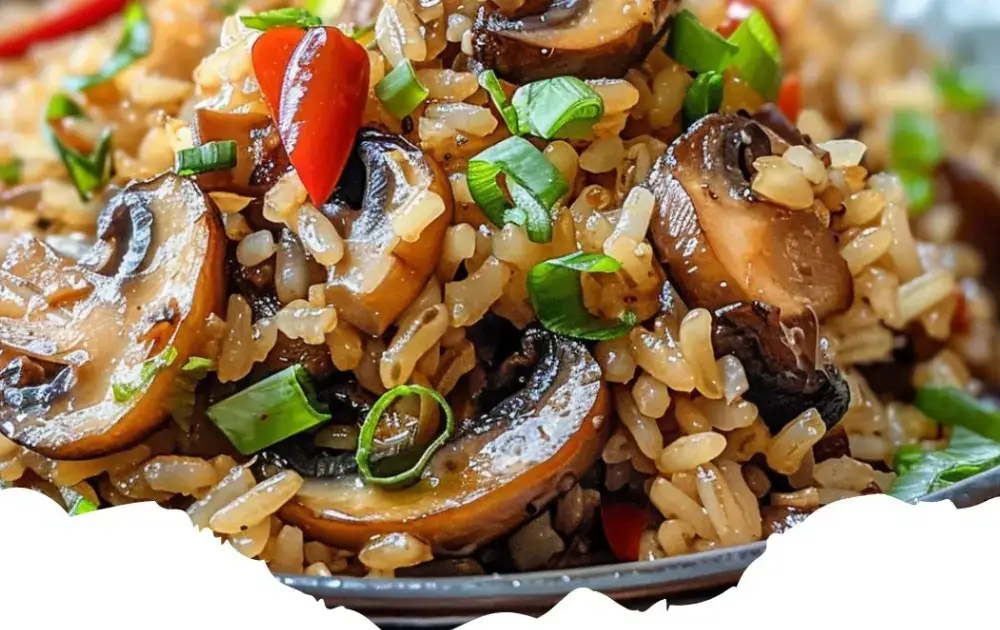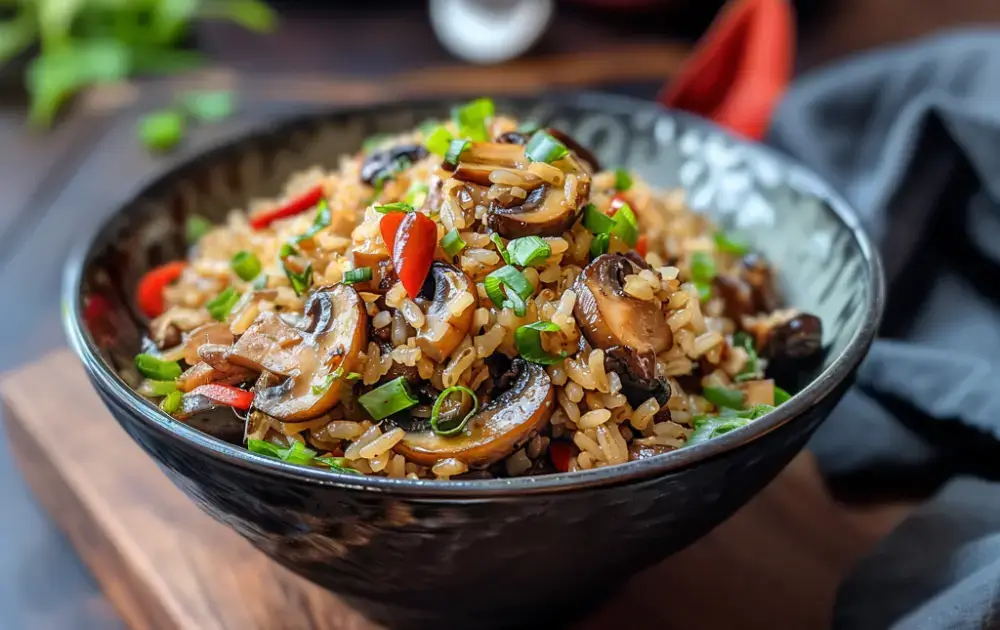Flavorful Mushroom Rice Recipe: A Savory Delight
Embark on a culinary journey where earthy mushrooms and fluffy rice unite to create a dish that tantalizes the taste buds and satisfies the soul. Mushroom rice, a harmonious blend of wholesome ingredients, promises a symphony of flavors and textures that captivate with each savory bite.
In this introduction, we’ll delve into the essence of mushroom rice, exploring its origins, versatility, and the myriad of possibilities it offers to culinary enthusiasts. From its humble beginnings to its modern-day interpretations, mushroom rice has evolved into a beloved dish cherished by food lovers around the world.
Join us as we uncover the secrets behind crafting the perfect mushroom rice, from selecting the finest ingredients to mastering the art of preparation. Whether you’re a seasoned chef or an aspiring home cook, prepare to be inspired as we embark on a culinary adventure with mushroom rice as our guide.
Choosing the Perfect Ingredients
Selecting the right ingredients is crucial for creating a delicious mushroom rice dish. Here’s a guide to help you choose the best ingredients:
- Mushrooms: Opt for fresh, firm mushrooms with a rich color and no signs of bruising or sliminess. Popular choices include button mushrooms, cremini mushrooms, and shiitake mushrooms, but feel free to experiment with different varieties for unique flavors and textures.
- Rice: Choose a long-grain rice variety such as basmati or jasmine for a light and fluffy texture. Alternatively, you can use medium-grain rice like Arborio for a creamier consistency, perfect for risotto-style mushroom rice dishes.
- Aromatics: Garlic and onion are essential for adding depth of flavor to mushroom rice. Select fresh garlic bulbs with firm cloves and onions that are firm and free from soft spots or sprouting.
- Broth or Stock: For added flavor, use high-quality vegetable or chicken broth as the cooking liquid for your mushroom rice. Opt for low-sodium options if you prefer to control the saltiness of the dish.
- Herbs and Spices: Fresh herbs like parsley, thyme, or chives can enhance the aroma and taste of mushroom rice. Ground spices such as black pepper, paprika, or dried thyme can also add depth and complexity to the dish.
- Olive Oil and Butter: Choose extra virgin olive oil for its robust flavor and health benefits. For richness and a touch of indulgence, select unsalted butter made from high-quality cream.
- Optional Ingredients: Consider incorporating additional ingredients such as diced bell peppers, peas, carrots, or diced tomatoes to add color, texture, and nutritional value to your mushroom rice. You can also experiment with protein sources like tofu, chicken, shrimp, or cooked lentils for added substance.
By carefully selecting fresh, high-quality ingredients, you can ensure that your rice dish is bursting with flavor and nutritional goodness. Take your time to choose the perfect ingredients, and let their natural flavors shine in every bite!
Unlocking the Benefits of Principal Ingredients
Mushrooms:
- Rich in Nutrients: Mushrooms are a powerhouse of essential nutrients including vitamins (such as vitamin D, B vitamins, and vitamin C), minerals (such as selenium, potassium, and copper), and antioxidants. These nutrients contribute to overall health and well-being, supporting immune function, bone health, and more.
- Low in Calories: With their low calorie content and high water content, mushrooms are an excellent choice for those looking to manage their weight or maintain a healthy diet. They provide a satisfying, flavorful addition to meals without adding excess calories.
- Source of Antioxidants: Mushrooms contain various antioxidants, such as selenium and ergothioneine, which help combat oxidative stress and reduce inflammation in the body. This can contribute to lower risk of chronic diseases and promote overall longevity.
Olive Oil:
- Heart-Healthy Fats: Olive oil is renowned for its high content of monounsaturated fats, particularly oleic acid. These fats have been associated with numerous health benefits, including improved heart health, reduced risk of cardiovascular diseases, and lower levels of LDL cholesterol (the “bad” cholesterol).
- Antioxidant Properties: Olive oil contains powerful antioxidants, such as vitamin E and polyphenols, which help protect cells from oxidative damage caused by free radicals. This antioxidant activity may contribute to reduced inflammation and lower risk of chronic diseases.
- Promotes Healthy Digestion: The monounsaturated fats in olive oil can aid in digestion by lubricating the digestive tract and promoting the absorption of nutrients. Additionally, olive oil has been linked to improved gut health and may help alleviate symptoms of digestive disorders such as inflammatory bowel disease.
Butter:
- Rich Flavor and Texture: Butter adds richness and depth of flavor to dishes, enhancing the overall taste experience. Its creamy texture lends a luxurious mouthfeel to foods, making them more satisfying and enjoyable to eat.
- Source of Fat-Soluble Vitamins: Butter is a natural source of fat-soluble vitamins A, D, E, and K, which play crucial roles in various bodily functions including immune health, bone health, and vision. Incorporating butter into meals can help ensure adequate intake of these essential vitamins.
- Satiety and Satisfaction: The fats in butter contribute to feelings of satiety and satisfaction after meals, helping to curb hunger and prevent overeating. Including moderate amounts of butter in recipes can promote a balanced approach to eating and support overall dietary enjoyment.
By incorporating these principal ingredients—mushrooms, olive oil, and butter—into your rice dish, you not only elevate its flavor and texture but also provide your body with a range of essential nutrients and health-promoting properties. Enjoy the culinary delights while reaping the benefits of these wholesome ingredients!
Health benefits:
Mushroom rice can offer several health benefits, thanks to its nutritious ingredients and cooking methods. Here are some of the potential health benefits associated with consuming mushroom rice:
- Nutrient-Rich: Mushroom rice typically contains a variety of nutritious ingredients such as mushrooms, rice, onions, and garlic. Mushrooms are low in calories but rich in essential nutrients like vitamins (such as vitamin D, B vitamins, and vitamin C), minerals (such as potassium, selenium, and copper), and antioxidants. Rice provides energy-boosting carbohydrates, and onions and garlic add flavor while offering their own health benefits, including immune support and cardiovascular health.
- Rich in Fiber: Depending on the type of rice used, mushroom rice can be a good source of dietary fiber. Brown rice, in particular, is higher in fiber compared to white rice. Fiber promotes digestive health by adding bulk to stool and facilitating regular bowel movements. It also helps regulate blood sugar levels and may lower cholesterol levels, reducing the risk of heart disease.
- Antioxidant Properties: Both mushrooms and olive oil, commonly used in mushroom rice recipes, contain antioxidants that help protect cells from damage caused by free radicals. These antioxidants may have anti-inflammatory properties and play a role in reducing the risk of chronic diseases such as cancer, heart disease, and neurodegenerative disorders.
- Heart Health: Olive oil, a common ingredient in mushroom rice recipes, is rich in monounsaturated fats, which are known to be heart-healthy. Consuming olive oil as part of a balanced diet may help lower levels of LDL cholesterol (the “bad” cholesterol) and reduce the risk of cardiovascular disease. Additionally, mushrooms contain compounds like beta-glucans and sterols, which may contribute to heart health by helping to regulate cholesterol levels and improve blood circulation.
- Weight Management: Mushroom rice can be a satisfying and flavorful meal option that is relatively low in calories, especially if prepared with minimal added fats and sodium. The combination of mushrooms and rice provides satiety and helps keep you feeling full for longer periods, which may aid in weight management by reducing overall calorie intake.
- Immune Support: Mushrooms contain beta-glucans, polysaccharides, and other bioactive compounds that have been shown to have immunomodulatory effects, meaning they can help regulate and support the immune system. Consuming mushroom rice regularly may contribute to a stronger immune response and better overall health.
- Versatility and Customization: Mushroom rice recipes can be easily customized to include other nutritious ingredients such as vegetables, lean proteins, and herbs, further enhancing their health benefits. Adding colorful vegetables like bell peppers, spinach, or peas increases the dish’s vitamin and mineral content, while incorporating lean proteins like chicken or tofu adds protein and satiety.
Overall, mushroom rice can be a delicious and nutritious addition to a balanced diet, offering a range of health benefits when prepared with wholesome ingredients and mindful cooking techniques.
Serving Suggestions
When it comes to serving mushroom rice, there are various delicious propositions that can elevate this dish into a satisfying and complete meal. Here are some serving propositions to consider:
- Main Course: Serve mushroom rice as the star of the meal by pairing it with protein-rich dishes such as grilled chicken breast, baked fish fillets, or marinated tofu. The savory flavors of the mushroom rice complement the protein while providing a hearty and satisfying base for the meal.
- Side Dish: Mushroom rice makes a fantastic side dish to accompany a wide range of main courses. Serve it alongside roasted meats, such as beef tenderloin or roasted turkey, or with vegetarian mains like stuffed peppers or vegetable stir-fries. Its rich flavors and textures will enhance any meal.
- Salad Topping: Use mushroom rice as a flavorful topping for salads to add depth and substance. Simply prepare a bed of mixed greens, vegetables, and your favorite salad toppings, then spoon the warm mushroom rice on top. Drizzle with a light vinaigrette or lemon-infused olive oil for a refreshing and satisfying salad option.
- Stuffed Vegetables: Transform mushroom rice into a delicious filling for stuffed vegetables such as bell peppers, tomatoes, or zucchinis. Prepare the vegetables by hollowing them out, then stuff them with the cooked mushroom rice mixture. Bake until the vegetables are tender and the rice is heated through for a flavorful and wholesome meal.
- Soup Garnish: Use mushroom rice as a garnish for soups to add texture and flavor. Ladle your favorite soup, such as creamy mushroom soup or vegetable broth-based soups, into bowls, then top each serving with a spoonful of warm mushroom rice. Sprinkle with fresh herbs like parsley or chives for a finishing touch.
- Bowl Meal: Create a nourishing bowl meal by layering mushroom rice with additional ingredients such as sautéed vegetables, protein sources like grilled tofu or shrimp, and flavorful sauces or dressings. Customize each bowl to your taste preferences and dietary needs for a satisfying and well-balanced meal option.
- Lunchbox Staple: Pack leftover mushroom rice into lunchboxes for a convenient and nutritious meal on the go. Pair it with sliced vegetables, a piece of fruit, and a source of protein such as boiled eggs or roasted chickpeas for a balanced and satisfying lunch option.
These serving propositions offer versatile ways to enjoy mushroom rice as a delicious and satisfying meal or side dish. Get creative and experiment with different combinations to discover your favorite serving style!

Frequently Asked Questions (FAQs)
- Can I use different types of mushrooms in mushroom rice? Yes, you can experiment with various types of mushrooms, such as button mushrooms, cremini mushrooms, shiitake mushrooms, or wild mushrooms, to customize the flavor and texture of your dish.
- Can I make mushroom rice ahead of time? Absolutely! Mushroom rice can be prepared ahead of time and stored in an airtight container in the refrigerator for up to several days. Simply reheat gently on the stove or in the microwave before serving.
- Is mushroom rice suitable for vegetarians and vegans? Yes, mushroom rice can be a delicious vegetarian or vegan dish, depending on the ingredients used. Simply ensure that any animal products, such as butter or chicken broth, are substituted with plant-based alternatives.
- How can I add extra protein to mushroom rice? You can boost the protein content of your mushroom rice by adding ingredients such as cooked lentils, tofu, tempeh, beans, or diced grilled chicken or shrimp.
- Can I freeze mushroom rice? While mushroom rice can be frozen, the texture of the rice may change slightly upon thawing. To freeze, portion the cooled rice into freezer-safe containers or bags, leaving some room for expansion, and freeze for up to several months. Thaw overnight in the refrigerator before reheating.
Conclusion
In conclusion, mushroom rice is a versatile and flavorful dish that offers a delightful combination of earthy mushrooms, aromatic spices, and fluffy rice. With endless variations and serving possibilities, mushroom rice is suitable for any occasion, whether as a comforting side dish, a hearty main course, or a flavorful addition to salads and bowls. By following simple cooking techniques and incorporating fresh, high-quality ingredients, you can create a delicious and nutritious mushroom rice dish that will impress family and friends alike. So, why wait? Get cooking and enjoy the savory goodness of mushroom rice today!

Mushroom Rice
- Total Time: 40 minutes
- Yield: 6
- Diet: Vegetarian
Description
Mushroom Rice is a flavorful dish that combines earthy mushrooms with fluffy rice, enhanced with aromatic spices and herbs. Perfect as a side dish or a satisfying main course, this dish offers a delightful balance of flavors and textures.
Ingredients
Instructions
Notes
– Ensure to rinse the rice before cooking to remove excess starch.
– Use a variety of mushrooms for depth of flavor.
– Customize with additional vegetables or protein as desired.
– Adjust seasoning to taste with salt and pepper
- Prep Time: 15 minutes
- Cook Time: 25 minutes
- Category: Side dish
- Method: Stovetop
- Cuisine: Fusion
Nutrition
- Serving Size: 1 cup
- Calories: 250
- Sugar: 3g
- Fat: 10g
- Carbohydrates: 35g
- Fiber: 3g
- Protein: 6g



